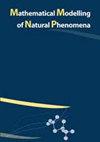Analytical detection of stationary Turing pattern in a predator-prey system with generalist predator
IF 2.1
4区 数学
Q2 MATHEMATICAL & COMPUTATIONAL BIOLOGY
引用次数: 4
Abstract
A prey-predator model with prey dependent Holling type-II functional response and a generalist predator exhibits complex dynamics in response to parameter variation. Generalist predators implicitly exploiting multiple food resources reduce predation pressure on their focal prey species that causes it to become more stable compared to a prey-predator system with specialist predator. In the temporal system, bistability and tristability are observed along with various global and local bifurcations. Existence of homogeneous and heterogeneous positive steady state solutions are shown to exist for suitable ranges of parameter values in the spatiotemporal diffusive system. Weakly nonlinear analysis using multi-scale perturbation technique is employed to derive amplitude equation for the stationary patterns near the Turing bifurcation threshold. The analytical results of the amplitude equations are validated using numerical simulations. We also identify bifurcation of multiple stable stationary patch solutions as well as dynamic pattern solution for parameter values in the Turing and Turing-Hopf regions.广义捕食者捕食系统中平稳图灵模式的分析检测
具有猎物依赖型Holling ii型功能响应和通才型捕食者的捕食-捕食模型对参数变化的响应具有复杂的动态特性。多面手捕食者隐性地利用多种食物资源,减少了对其重点猎物物种的捕食压力,使其与具有专业捕食者的捕食系统相比变得更加稳定。在时间系统中,观察到双稳性和三稳性以及各种全局和局部分岔。证明了时空扩散系统在适当的参数值范围内存在齐次和非均匀正稳态解。利用多尺度摄动技术进行弱非线性分析,推导了图灵分岔阈值附近平稳模式的振幅方程。数值模拟验证了振幅方程的解析结果。在图灵和图灵-霍普夫区域中,我们还发现了多个稳定平稳斑块解的分岔以及参数值的动态模式解。
本文章由计算机程序翻译,如有差异,请以英文原文为准。
求助全文
约1分钟内获得全文
求助全文
来源期刊

Mathematical Modelling of Natural Phenomena
MATHEMATICAL & COMPUTATIONAL BIOLOGY-MATHEMATICS, INTERDISCIPLINARY APPLICATIONS
CiteScore
5.20
自引率
0.00%
发文量
46
审稿时长
6-12 weeks
期刊介绍:
The Mathematical Modelling of Natural Phenomena (MMNP) is an international research journal, which publishes top-level original and review papers, short communications and proceedings on mathematical modelling in biology, medicine, chemistry, physics, and other areas. The scope of the journal is devoted to mathematical modelling with sufficiently advanced model, and the works studying mainly the existence and stability of stationary points of ODE systems are not considered. The scope of the journal also includes applied mathematics and mathematical analysis in the context of its applications to the real world problems. The journal is essentially functioning on the basis of topical issues representing active areas of research. Each topical issue has its own editorial board. The authors are invited to submit papers to the announced issues or to suggest new issues.
Journal publishes research articles and reviews within the whole field of mathematical modelling, and it will continue to provide information on the latest trends and developments in this ever-expanding subject.
 求助内容:
求助内容: 应助结果提醒方式:
应助结果提醒方式:


